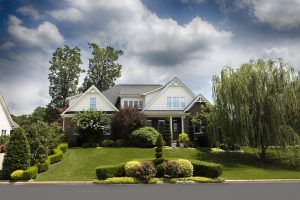
Once again, a traditional symbol has become a target of those who attack private property rights and the American way of life. In this case, the symbol is the lawn – those closely-cropped grassy areas that surround most single-family homes. The basis for the attack is very typically environmentalism and racism.
The messenger is an article in The New York Times. Its title is unassuming enough – “The Great American Lawn: How the Dream was Manufactured.” The vehicle is an embedded seven-minute film, produced by David Botti.
The Attack
The film’s first minute summarizes the environmental concerns:
- More water is used to irrigate grass than any other plant in the country.
- Americans use millions of pounds of pesticides to keep grass weed- and bug-free.
- Lawnmowers pollute the air and cause climate change.
- Lawns are environmentally useless.
Later, Mr. Botti makes the link to racism. George Washington and Thomas Jefferson planted large lawns at their estates. These lawns were planted and maintained through the back-breaking labor of enslaved people.
Help Remove Jesus Toilet Lid on Amazon
The film furthers the racist narrative by asserting that mechanization made lawns available for the “privileged masses” about the year 1870 with manual lawnmowers. Then it fast-forwards to returning G.I.’s from World War II who settled in the suburbs with green lawns – unless they were black. The narrator condemns “a symbol of an American dream that is recognized by most, but only attainable to some.”
A Rebuttal
Such attacks are simplistic in their reasoning. Like all plants, grass absorbs carbon dioxide and emit oxygen. Thus, they can serve an environmental function.
The racism argument is curious because it is selective. Plants like Cotton and rice were also cultivated by the enslaved, but no one argues that those crops should no longer be grown or consumed.
Satanic Christ Porn-blasphemy at Walmart — Sign Petition
Finally, most African-Americans homeowners have and continue to maintain lawns of their own. Even a viewer of this film sees an African-American mother pushing a lawnmower assisted by her two young sons.
The target of the film and article goes much beyond a condemnation of the lowly plant.
Private Property is a Threat to the Left
Indeed, the target is private property, and all it represents. Think about the adage, “A man’s home is his castle.” That is more than a clever saying; it is a doctrine of English Common Law. It meant that the owner of a home, however modest, has the right to defend it against trespass. That defense includes usurpation at the hands of the government. The Constitution alludes to this idea by limiting the government’s power of eminent domain.
How Panera’s Socialist Bread Ruined Company
The lawn is a symbol of private land ownership. The one-family home symbolized the widespread economic opportunity of homeownership that is open to Americans of most walks of life. It is contrary to the socialist mentality.
In the fifties, there was a French saying that, roughly translated, goes, “If you want to convert a communist, give him a house.” The point is simple – communism and socialism stop being attractive if you have something substantial to lose. Ownership also entails care and responsibility that endears property to the owners.
Lawns have other features that make them unattractive to the left. Lawns are beautiful and accentuate the home that it surrounds. They are places of recreation and centers of family life. By its very nature, a lawn is a luxury – albeit a commonly available one. Leftists hate even accessible luxuries since they oppose their egalitarian metaphysics. The lawn creates happy landowners of the working class that clashes with their narratives of misery.
The socialist model is found in public family housing concentrated in large apartment blocks without private lawns. After World War II, “urban planners” built soulless “projects” like Cabrini Green in Chicago, Pruitt-Igoe in St. Louis, and the Marcy Projects in Brooklyn. Residents would be tenants of the state, never owners. Belonging to no one, they were often ill-maintained and magnets for crime and vice. Residents often were reduced to barricading themselves up in their apartments.
Today, neighborhoods of single-family home thrive. The “projects” are either demolished or gang-infested. Richard Rothstein of the University of California-Berkley characterized these projects in a study in the liberal The American Prospect titled “Public Housing: Government-Sponsored Segregation.”
The Importance of Slogans and Symbols
The success story of the American family home is too secure to be attacked frontally. Most Americans still aspire to homeownership.
Thus, the left attacks this institution by way of symbols. An attack on the lawn is a subtle way of attacking private property while professing politically correct motives for their opposition.
[like url=https://www.facebook.com/ReturnToOrder.org]
The left can use causes like the environment and racial social justice as a means to separate Americans from the right to private property and its corresponding way of life. Making the link to the environmental concerns turns lawn owners into promoters of climate change. Labeling lawns as racist structures feeds the most recent narratives that keep the left alive.
The only way to fight this leftist propaganda is to present the facts that unmask the left’s attacks. The lawn is a symbol of success for all races. It is not an eco-failure. Any attempt to present it otherwise is pure fearmongering.


